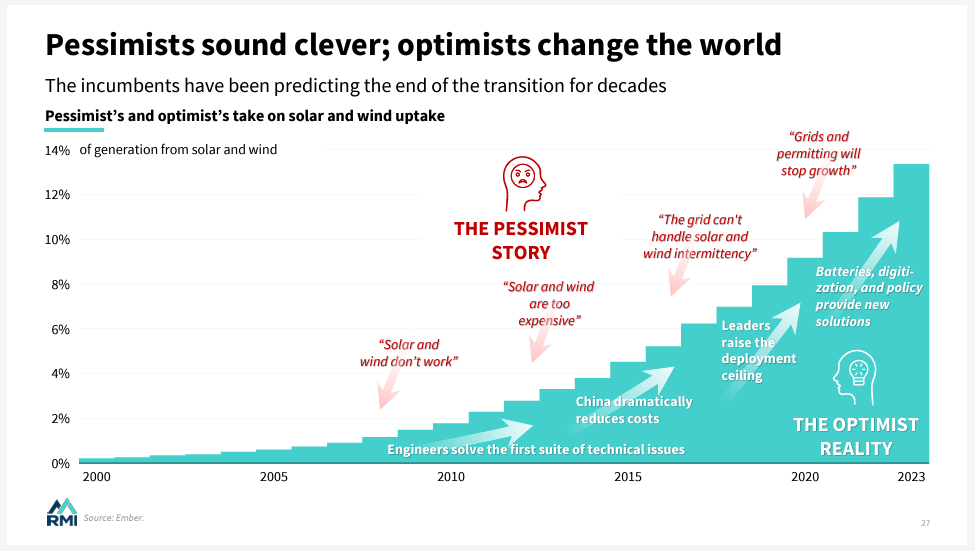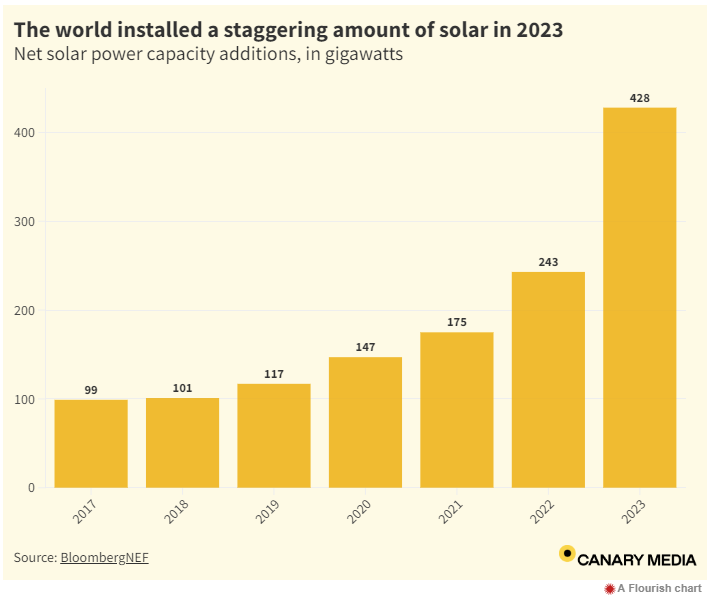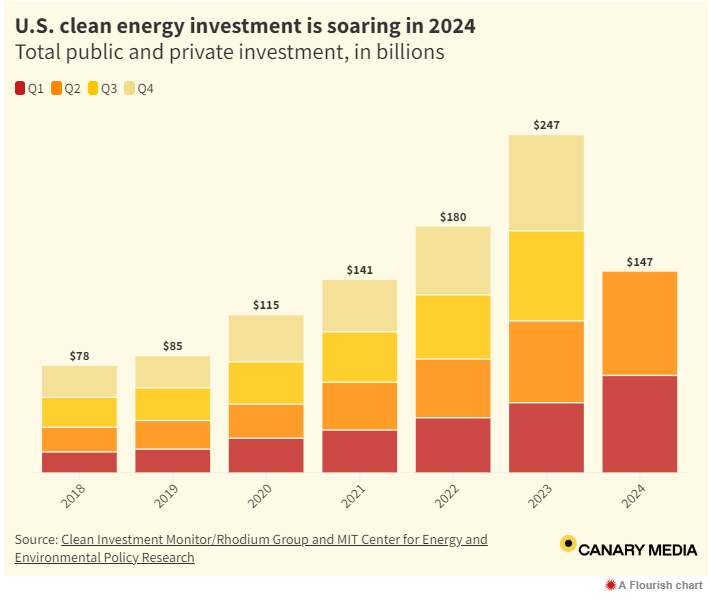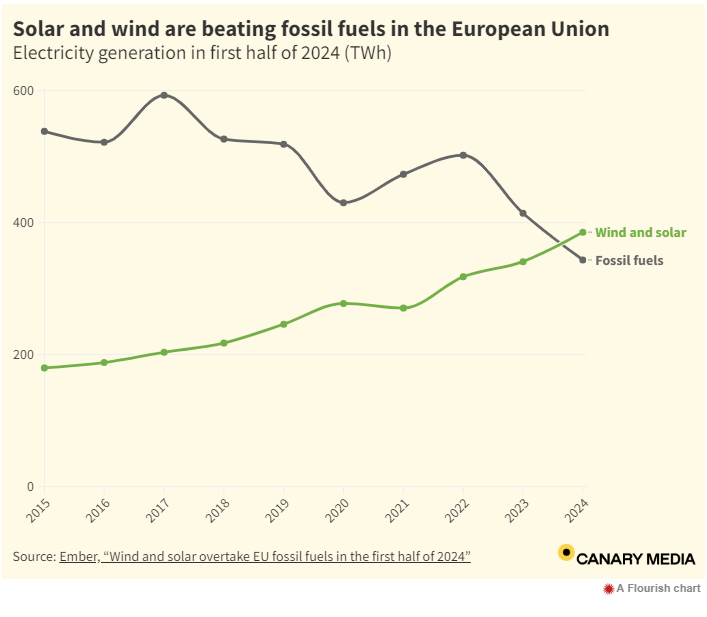Publish Date: September 16th, 2024
It’s easy to look at the state of our world and see the negatives. We are facing incredibly complex challenges, after all.
While we don’t advocate for ignoring the negatives, we also aim to not get bogged down by them. Instead, at Namaste Solar, we choose to move forward as optimists. It may take more energy and creativity to look for new possibilities and to envision an equitable and sustainable future. But it’s worth the effort.
Finding solutions and acting on them is easier when we feel bright about the challenges we’re facing. Using good climate news stories to be inspired and encouraged is an advantageous practice. It helps to widen and lighten your perspective, in the face of the doom-and-gloom media cycle. And it’s energizing, strengthening your capacity to move forward in confidence. And it’s the optimists that change the world.

Source: RMI Cleantech Revolution Webinar
With that in mind, welcome to the first edition of our Good Climate News series, where we share positive climate news. We’re doing our best to be a source of honest and transparent news in a way that helps you see the immense progress being made and the potential for further positive changes.
Bring On the Good News
This summer, positive climate news is everywhere. It’s so widespread that you can find a good climate news story across almost any industry. We compiled 10 of our favorite stories for this edition – covering renewable energy, electric vehicles, heat pumps and electrification, battery storage, and agriculture. Without further ado, let’s bring on the good news.
Renewable Energy
- The Cleantech Revolution is here – The Rocky Mountain Institute (RMI) is an independent, nonpartisan, nonprofit that works to transform global energy systems through market-driven solutions. They’re working to align these solutions with a 1.5 degree C future and secure a clean, prosperous, zero-carbon future for all. In Q3, they hosted a webinar, entitled The Cleantech Revolution, where they showed a generous amount of data to support the idea that the transition to cleaner technology is here and now. We’ve included the executive summary from the webinar below, but you can view the slide deck in its entirety here. And you can watch the webinar replay here.
 Source: RMI Cleantech Revolution Webinar
Source: RMI Cleantech Revolution Webinar
- Solar power installations have shattered global records – Canary media reported new data just last month that shows the world installed a staggering amount of solar in 2023. In 2023, 428 gigawatts’ of solar was installed, which is a 76% increase from all 2022 installations. To break that down further, 243 gigawatts’ were installed in 2022 and 175 gigawatts’ in 2021. Both of those figures set records of their own. But in 2023, the gigawatts’ deployed were greater than the amount deployed across those two previous, record-breaking years combined.
 Source: Canary Media
Source: Canary Media
- Clean energy investment is soaring – When President Biden signed the Inflation Reduction Act (IRA), it set a historic precedent. As the largest investment in climate action in history, it established a wide array of clean energy programs meant to supercharge spending on climate solutions. And it’s working. The U.S. cleantech investment reached $147 billion in the first 6 months of 2024, which is a more than 30% jump from the first half of 2023. When compared with the pre-IRA era, the change is massive. In 2021, the year before the law was passed, investors put $141 billion into the cleantech world – less than the first 6 months of 2024. And for further comparison, the whole of 2020 saw just $115 billion spent.
 Source: Canary Media
Source: Canary Media
- Solar and wind generation surpass fossil fuels for the first time in the EU – The goal of cleantech is to significantly reduce reliance on fossil fuels for electricity generation by transitioning to renewable energy sources, essentially aiming to achieve a power grid primarily powered by renewables. And the EU just hit a big milestone on the journey to that goal. For the first time ever, wind and solar produced more electricity for the EU than coal and gas did across the first half of 2024. In addition, coal generation has dropped by 24% and gas by 14% compared to the same period last year. And this marks the first time gas and coal generation have declined in the EU without energy demand also trending downward.
 Source: Canary Media
Source: Canary Media
- Solar installations are getting creative, including the first ever solar covered canal in the US – Funded by the IRA, the first canal-based solar project in the U.S. is nearing completion on tribal lands south of Phoenix, Arizona. Thousands of miles of federally owned canals stretch across the country and placing solar panels over these canals could create a gigawatt-scale source of clean energy. In addition, the panels over the canal prevent water from evaporating and inhibit algae growth. While this market is in the pilot stage, the potential is massive.
 Solar panels over canal on tribal lands, south of Phoenix, Arizona
Solar panels over canal on tribal lands, south of Phoenix, Arizona
Electric Vehicles
- EV battery mining gets an optimistic face lift – While many people worry about the long-term viability of mining lithium for EV batteries, RMI has found that even as battery demand surges, the combined forces of efficiency, innovation, and circularity will drive peak demand for mined materials within a decade – and may even avoid mineral extraction altogether by 2050. All of this compounds to help us move from linear extraction – like fossil fuels – to a circular loop. Their new report found that accelerating six key solutions – deploying new battery chemistries, making batteries more energy-dense, recycling their mineral content, extending their lifetime, improving vehicle efficiency, and improving mobility efficiency – can help us reach net-zero mineral demand in the 2040s.
Heat Pumps and Electrification
- The city of Denver deploys heat pump rebates, accelerating the transition to home electrification – Denver’s rebate is sweet enough on it’s own, saving homeowners thousands of dollars when they switch from fossil fuel heating and cooling to electric, but you can stack it with other federal, local, and utility incentives, sweetening the pot even more. And there’s no need to wait to file your taxes to see the benefits of this rebate. The contractor you work with will deduct the rebate upfront from the project’s cost.
- The EPA sends nearly $500 million to New England and Alaska to replace fossil fueled heating with efficient electric heat pumps – Another benefit of the IRA are the Climate Pollution Reduction Grants. This $4.3 billion in funding is designed to deploy funding to states, local governments, tribes, and territories to develop and implement ambitious plans for reducing greenhouse gas emissions. Initiatives in Alaska and New England were among 25 projects selected by the EPA to receive funding. Southeast Alaska will receive $38.6 million to shift more than 6,000 homes from expensive oil heating to heat pumps. And the coalition of Connecticut, Maine, Massachusetts, New Hampshire, and Rhode Island will receive $450 million for the New England Heat Pump Accelerator, a program to supercharge heat-pump deployment in the region. Heat pumps are a part of the clean energy transition and can reduce household carbon emissions by 36 to 64 percent.
Battery Storage
- The U.S. battery boom is well underway, with overall storage installations growing 84% – In Q1 of 2024, nearly 1.3 gigawatts of battery storage were installed at power plants, homes, and commercial facilities across the U.S making this the best-ever start to a year for this sector. Pair this with the exponential growth of the U.S. solar capacity and the future looks bright.
 Source: Canary Media
Source: Canary Media
Agriculture
- A new model aims to build a robust regenerative agriculture market – A decade ago the conversation was moving toward organic agriculture as the standard. Today, it’s shifted again to regenerative agriculture. It’s a way of working with the land that can dramatically reduce the carbon in the atmosphere. The goal is to rebuild soil health and, in the process, sequester carbon from the atmosphere and return it to the soil. Currently, there’s a “missing middle” in the regenerative supply chain and a nonprofit called Mad Agriculture is working on building this middle, making it easier for farmers to make the switch. Mad Agriculture is hoping to improve the ecosystem for American farmers who want to transition to regenerative organic farming.
Good Climate News is in Abundance
Positive climate news is a feedback loop. The more we see, the more encouraged we feel to act. And the more we act, the more good climate news there is.
We love solar, battery backup and heat pumps, as part of the climate solution and are proud to contribute to the massive momentum of the industry. If you’d like to join us and be part of the cleantech revolution, reach out to us today. We’ll always give you straightforward advice to help you reach your goals. Click the button below to get started.


